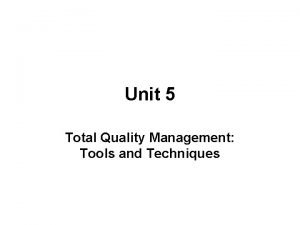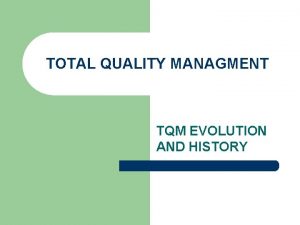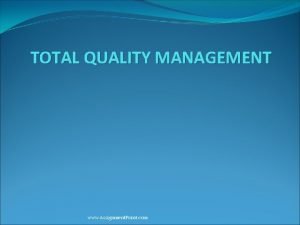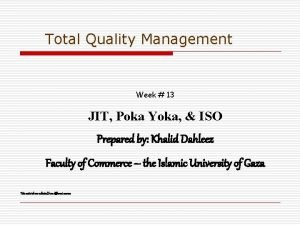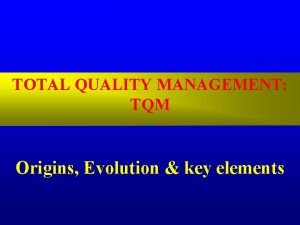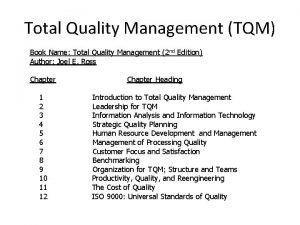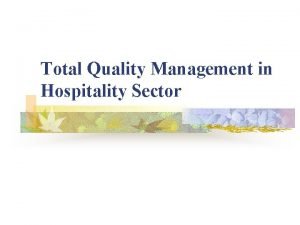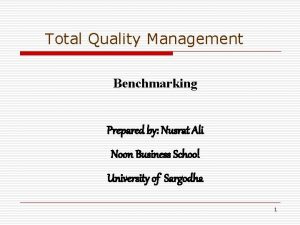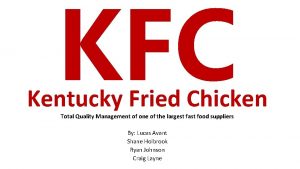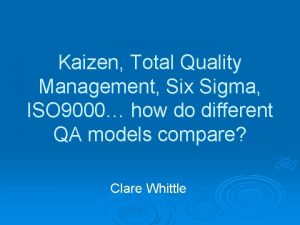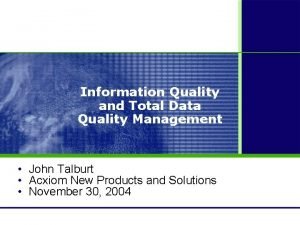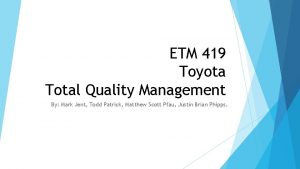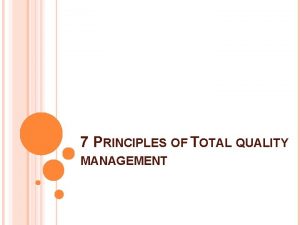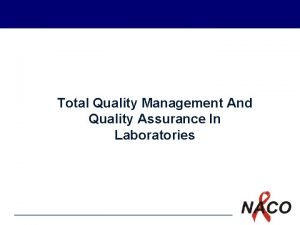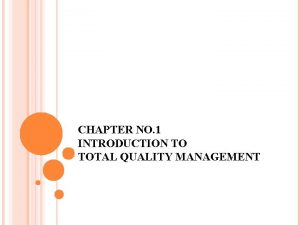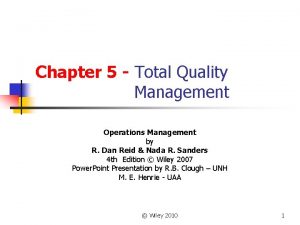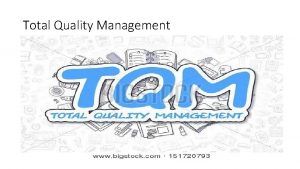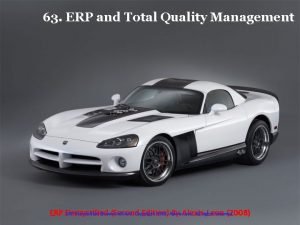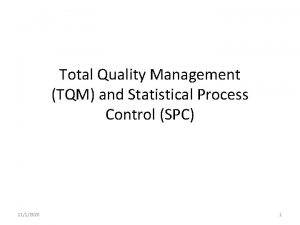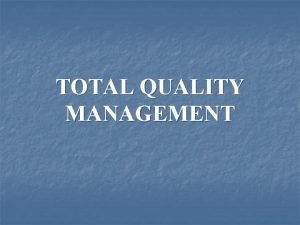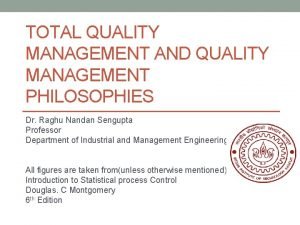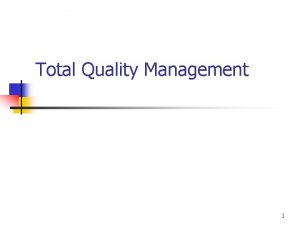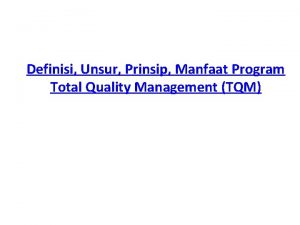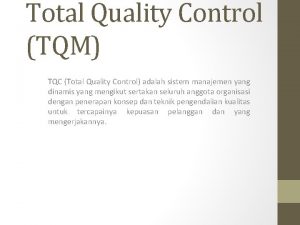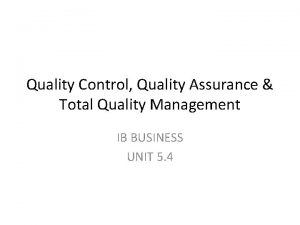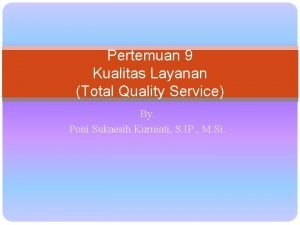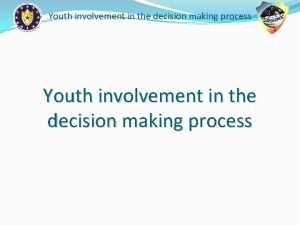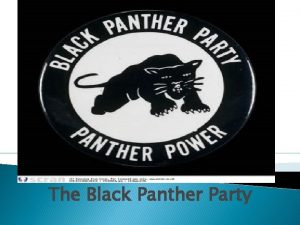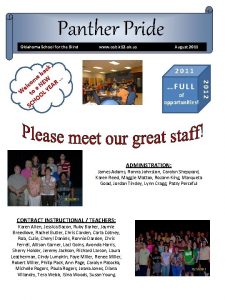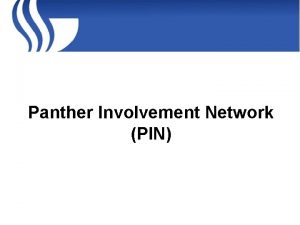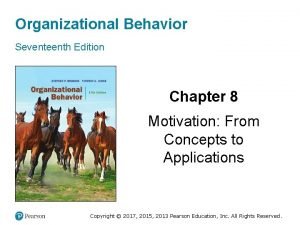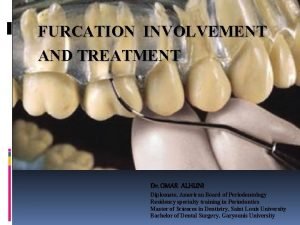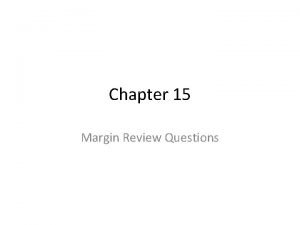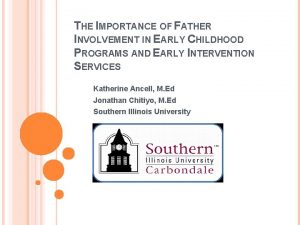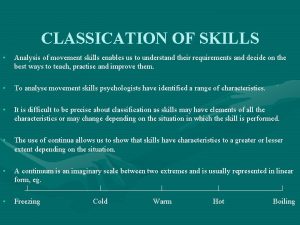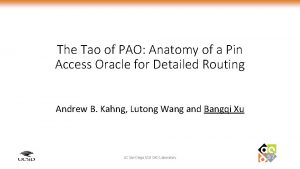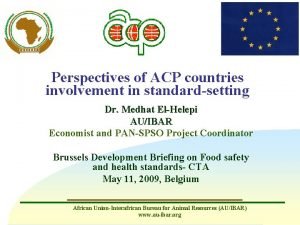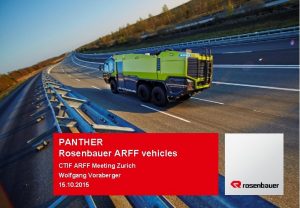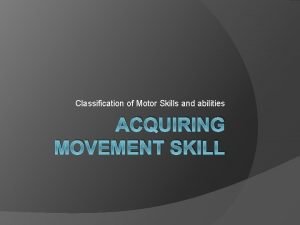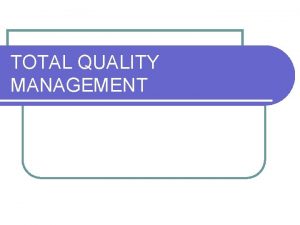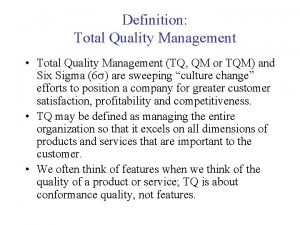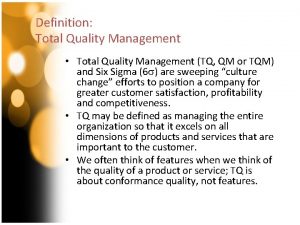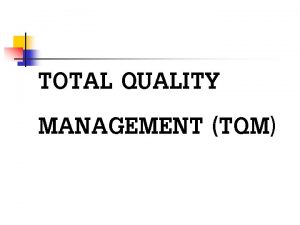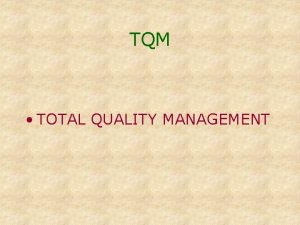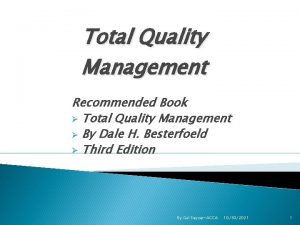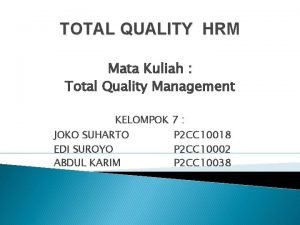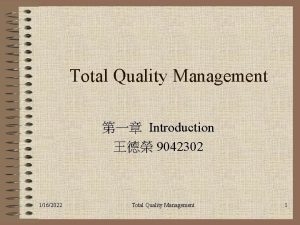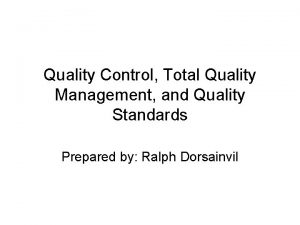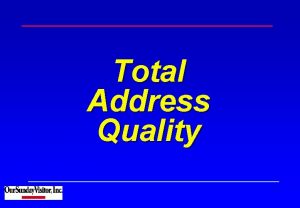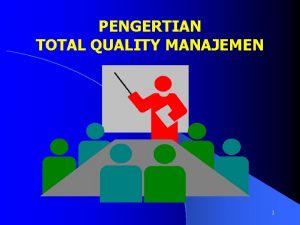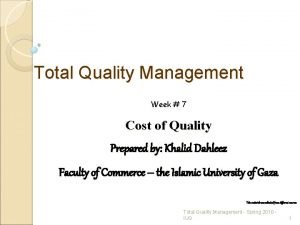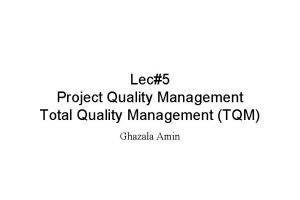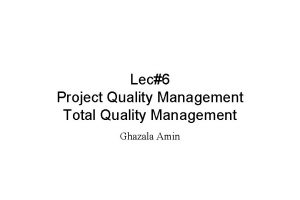Total Quality Management Week 5 People HR Involvement































































- Slides: 63

Total Quality Management Week # 5 People, HR, & Involvement Prepared by: Khalid Dahleez Faculty of Commerce – the Islamic University of Gaza This material was collected from different sources Total Quality Management – IUG – Spring 2010 1

HR (Main Questions) The effective management of human resources is at the heart of any successful quality management process. The following questions under score this point: What is the organization’s record of success at finding the right people who would support or promote a quality culture? Is the organization able to retain the right people? Is the organization investing a sufficient amount of resources in professional development and training for staff? Are hiring and firing decisions and functions (at all levels) linked to the organization’s mission, vision, and guiding principles? Does the organization value employee input and participation? Does the organization handle employee reward and recognition in a manner that complements the organization’s mission, vision, and guiding principles? Total Quality Management – IUG – Spring 2010 2

Deming’s Philosophy Institute training on the job: Training involves teaching employees the best methods of achieving quality in their jobs and the use of modern tools. Break down barriers between departments to build teamwork: Quality and productivity can be improved when departments have open communication and coordination based on the common organization goals. Drive fear out in the workplace: Employees need to feel secure in order for quality to be achieved. Fear of asking questions, reporting problems, or making suggestions will prevent the desired climate of 3 Total Quality Management – IUG – Spring 2010

Deming’s Philosophy Eliminate quotas on the shop floor: Don’t focus on quotas, like a focus on production, which may encourage and reward people for numerical targets, frequently at the expense of quality. Create conditions that allow employees to have pride in their work manship and abolish annual reviews and merit ratings: A major barrier to pride of workmanship is a merit or appraisal system based on targets, quotas, or some list of personal traits that have little to do with incentives related to quality. Institute a program of education and self improvement: Deming emphasizes training, not only in the methods of the specific job but in the tools and techniques of quality control, as well as instruction in teamwork and the philosophy of a quality culture. Total Quality Management – IUG – Spring 2010 4

Understand People, normally, need security and independence at the same time. People are sensitive to rewards and punishments and yet are also strongly self motivated. People like to hear a kind word of appreciation. People can process only a few facts at a time; thus, a leader needs to keep things simple. People trust their gut reaction more than statistical data. People don’t trust a leader (or boss) if the words are inconsistent with the his/her actions. Total Quality Management – IUG – Spring 2010 5

Coordinate the system and the people Quality improvement can result from a reduction in cost or cycle time, an increase in throughput, or a decrease in variation within the process. In the past, the focus in achieving such improvement was frequently the system — traditional techniques and methods of quality control. Such a focus may overlook the fact that operation of the system depends on people, and no system will work with disinterested or poorly trained employees. Total Quality Management – IUG – Spring 2010 6

“Involvement of People” People at all levels are the essence of an organization and their full involvement enables their abilities to be used for the organization´s benefit. At the heart of TQM is the concept of intrinsic motivation involvement in decision making. Employee involvement is a process for empowering members of an organization to make decisions and to solve problems appropriate to their levels in the organization. Total Quality Management – IUG – Spring 2010 7

Involvement (Key benefits) Motivated, committed and involved people within the organization. Innovation and creativity in furthering the organization’s objectives. People being accountable for their own performance People eager to participate in and contribute to the organization’s performance Accepting ownership and responsibility to solve problems, Actively seeking opportunities to make improvements, Actively seeking opportunities to enhance their competencies, knowledge and experience, freely sharing knowledge and experience in teams and groups, Total Quality Management – IUG – Spring 2010 8

Involvement of people focusing on the creation of value for customers, being innovative and creative in furthering the organisations objectives, better representing the organisation to customers, local communities and society at large Other Way: for policy and strategy formulation, people effectively contributing to improvement of the policy and strategies of the organisation; for goal and target setting, people sharing ownership of the organisation's goals; for operational management, people being involved in appropriate decisions and process improvements; for human resource management, people being more satisfied with their jobs and being actively involved in their personal growth and development, for the organisation's benefit. Total Quality Management – IUG – Spring 2010 9

Aspects Of Employee Involvement Employee Participation EMPLOYEE MOTIVATION EMPLOYEE EMPOWEREMENT TEAMS AND TEAM WORK RECOGNITION AND REWARD PERFORMANCE APPRAISAL Total Quality Management – IUG – Spring 2010 10

Employee Participation § Employee participation can be defined as the degree to which employees in a firm engage in various quality management activities. § By participating in quality management activities, employees acquire new knowledge, see the benefits of the quality disciplines, and obtain a sense of accomplishment by solving quality problems. § A remarkable characteristic of employee participation is teamwork. Breakdown barriers between departments. People in research, design, sales, and production must work as a team (Deming’s 9 th point). § If several knowledgeable people are brought into the decisionmaking process, a number of worthwhile possibilities may be uncovered. Total Quality Management – IUG – Spring 2010 11

Employee Participation § TQM implementation practice is formation of short-term problemsolving teams (SEPG). § Problem-solving teams work on a wide variety of tasks, ranging from cross-functional involvement in tackling quality problems to solving within-functional quality problems. § TQM firms create employee suggestion systems. Production workers should regularly participate in operational decisions such as planning, goal setting, and monitoring of performance. § They are encouraged to make suggestions and take a relatively high degree of responsibility for overall performance. § Employees should be encouraged to inform managers or supervisors concerning conditions that need correction (e. g. , process defects, incompetent staff and poor tools). Total Quality Management – IUG – Spring 2010 12

EMPLOYEE MOTIVATION At the heart of TQM is the concept of intrinsic motivation involvement in decision making. Scott Defines “ Motivation is a process of stimulating people to accomplish desired goals”. Importance of Motivation Improves Employee Involvement. Promotes Job Satisfaction. Promotes Interpersonal Cooperation. Total Quality Management – IUG – Spring 2010 13

Yoshio Kondo Four points of action to support motivation: 1. when giving work instruction, clarify the true aims of the work 2. see that people have a strong sense of responsibility towards their work 3. give time for the creation of ideas 4. nurture ideas and bring them to fruition Total Quality Management – IUG – Spring 2010 14

EMPLOYEE MOTIVATION Maslow’s hierarchy of five needs. 1. physiological needs - Adequate Wage 2. Safety - Job security 3. Social needs - Recognition , Colleagues 4. Esteem needs - Promotion, Thank you 5. Self Actualization Needs - Using abilities to the full. Total Quality Management – IUG – Spring 2010 15

EMPLOYEE EMPOWEREMENT Empower ability/ authority Operation definition of empowerment Empowerment is an environment in which people have the ability, the confidence & the commitment to take the responsibility & ownership to improve the process & initiate the necessary steps to satisfy customer requirements within well defined boundaries in order to achieve organizational values and goals. Total Quality Management – IUG – Spring 2010 16

Principles for Empowering Employees 1. 2. 3. 4. 5. 6. Tell people what their responsibilities are? Give them the authority. Give them knowledge and information. Provide them with feedback. Trust them. Treat them with dignity and respect. Total Quality Management – IUG – Spring 2010 17

CHARACTERISTICS OF EMPOWERED EMPLOYEES 1. They feel responsible for their own task. 2. They balance their own goals with the organization. 3. They are challenged and encouraged. 4. They monitor and improve their work continuously. 5. They find new goals and change challenges. Total Quality Management – IUG – Spring 2010 18

Organizing for Involvement & Participation Properly organized and administered small groups and teams are an effective motivational device for improving productivity and quality. They can reduce the overlap and lack of communication in a functionally based classical structure characterized by chain of command, territorial battles, and parochial outlooks. Team membership, particularly in a cross functional team, reduces many of these barriers and encourages an integrative systems approach to achievement of common objectives — those that are common to both the company and the team or group. Total Quality Management – IUG – Spring 2010 19

Quality Director or Manager TQM appointments Many organizations have realized the importance of the contribution a senior, qualified director of quality can make to the prevention strategy. Smaller organizations may well feel that the cost of employing a full-time quality manager is not justified, other than in certain very high risk areas. In these cases a member of the management team should be appointed to operate on a parttime basis, performing the quality management function in addition to his/her other duties. Total Quality Management – IUG – Spring 2010 20

Quality Director or Manager Assign a TQM director, manager or coordinator This person will be responsible for the planning and implementation of TQM. He will be chosen first for project management ability rather than detailed knowledge of quality assurance matters. Depending on the size and complexity of the organization, and its previous activities in quality management, the position may be either full or part-time, but it must report directly to the Chief Executive. Total Quality Management – IUG – Spring 2010 21

Quality Director or Manager To obtain the best results from a quality director/manager, he should be given sufficient authority to take necessary action to secure the implementation of the organization’s quality policy, and must have the personality to be able to communicate the message to all employees, including staff, management and directors. Occasionally the quality director/manager may require some guidance and help on specific technical quality matters, and one of the major attributes required is the knowledge and wherewithal to acquire the necessary information and assistance. Total Quality Management – IUG – Spring 2010 22

Quality Director or Manager The first objectives for many ‘quality managers’ will be to gradually disengage themselves from line activities, which will then need to be dispersed throughout the appropriate operating departments. This should allow quality to evolve into a ‘staff’ department at a senior level, and to be concerned with the following throughout the organization: Ø Encouraging and facilitating quality improvement. Ø Monitoring and evaluating the progress of quality improvement. Ø Promoting the ‘partnership’ in quality, in relations with customers and suppliers. Total Quality Management – IUG – Spring 2010 23

Quality Director or Manager Planning, managing, auditing, and reviewing quality systems. Planning and providing quality training and counseling or consultancy. Giving advice to management on: A. B. C. D. Establishment of quality systems and process control. Relevant statutory/legislation requirements with respect to quality. Quality improvement programs necessary. Inclusion of quality elements in all job instructions and procedures. Total Quality Management – IUG – Spring 2010 24

Quality Director or Manager Quality directors and managers have an initial task, however, to help those who control the means to implement this concept – the leaders of industry and commerce – to really believe that quality must become an integral part of all the organization’s operations. The shift in ‘philosophy’ will require considerable staff education in many organizations. Not only must people in other functions acquire quality related skills, but quality personnel must change old functions acquire new skills. Total Quality Management – IUG – Spring 2010 25

Quality Director or Manager The challenge for many quality professionals is not so much making changes in their organization as recognizing the changes required in themselves. It is more than an overnight job to change the attitudes of an inspection police force into those of a consultative, team-oriented improvement force. This emphasis on prevention and improvement-based systems elevates the role of quality professionals from a technical one to that of general management. Total Quality Management – IUG – Spring 2010 26

Quality Management Advisor Appoint a quality management advisor A professional expert on quality management will be required to advise on the ‘technical’ aspects of planning and implementing TQM. This is a consultancy role, and may be provided from within or without the organization, full or part-time. This person needs to be a persuader, philosopher, teacher, adviser, facilitator, reporter and motivator. Total Quality Management – IUG – Spring 2010 27

Quality Management Advisor He must clearly understand the organization, its processes and interfaces, be conversant with the key functional languages used in the business, and be comfortable operating at many organizational levels. On a more general level this person must fully understand be an effective advocate and teacher of TQM, be flexible and become an efficient agent of change. Total Quality Management – IUG – Spring 2010 28

Councils, Committees and teams The creation of cost effective quality improvement is difficult, because of the need for full integration with the organization’s strategy, operating philosophy and management systems. It may require an extensive review and substantial revision of existing systems of management and ways of operating. Authority must be given to those charged with following TQM through with actions that they consider necessary to achieve the goals. Total Quality Management – IUG – Spring 2010 29

Quality Council The following steps are suggested in general terms. Clearly, different types of organization will have need to make adjustments to the detail, but the component parts are the basic requirements. A disciplined and systematic approach to continuous improvement may be established in a quality council. The council should meet at least monthly to review strategy, implementation progress, and improvement. It should be chaired by the Chief Executive, who must attend every meeting. Total Quality Management – IUG – Spring 2010 30

Quality Council The council members should include the top management team and the chairmen of any ‘site’ TQM steering committees or process quality teams, depending on the size of the organization. The objectives of the council are to: Ø Provide strategic direction on TQM for the organization. Ø Establish plans for TQM on each ‘site’. Ø Set up and review the process quality teams that will own the key or critical business processes. Ø Review and revise quality plans for implementation. Total Quality Management – IUG – Spring 2010 31

TEAMS AND TEAMWORK TEAM Group of people working together to perform common achievement / goal. TEAMWORK Cumulative actions of the team during the achievement of goal. BENEFITS OF TEAMWORK • Improved solutions to quality problems. • improved communication. • improved integration. Total Quality Management – IUG – Spring 2010 32

TEAMS AND TEAMWORK Characteristics of successful Teams Sponsor person from qty council. Team charter document/ person indicating mission Team composition shouldn’t exceed 10 members. Training members are well trained. Ground rules basic rules. Clear Objectives Stated clearly. Accountability periodic status report. Total Quality Management – IUG – Spring 2010 33

TEAMS AND TEAMWORK Well defined decision procedures. Resources tools. Trust – management trust on team. Effective problem solving efficient methods. Open communication everyone should talk. Appropriate leadership leader who leads. Balanced participation Cohesiveness single unit not in subgroups. Total Quality Management – IUG – Spring 2010 34

TEAMS AND TEAMWORK Barriers To Team Process Insufficient training Lack of management support Lack of planning Project scope too large No clear measures of success Total Quality Management – IUG – Spring 2010 35

Process Quality Teams The process quality teams (PQTs) and any site TQM steering committees should also meet monthly, shortly before the council meetings. Every senior manager should be a member of at least one PQT. This system provides the “top-down” support for employee participation in process management and development, through either a quality improvement team or a quality circle program. It also ensures that the commitment to TQM at the top is communicated effectively through the organization. Total Quality Management – IUG – Spring 2010 36

Process Quality Teams The three-tier approach of quality council, process quality teams (PQTs) and quality improvements teams (QITs) allows the first to concentrate on quality strategy, rather than become a senior problem solving group. Progress is assured if the PQT chairmen are required to present a status report at each meeting. The PQTs or steering committees all control the QITs and have responsibility for: Ø The selection of projects for the QITs. Ø Providing an outline and scope for each project to give to the QITs. Total Quality Management – IUG – Spring 2010 37

Process Quality Teams The appointment of team members and leaders. Ø Monitoring and reviewing the progress and results from each QIT project. The PQT members must be given the responsibility and authority to represent their part of the organization in the process. The members must also feel that they represent the team to the rest of the organization. In this way the PQT will gain knowledge and respect and be seen to have the authority to act in the best interests of the organization, with respect to their process. Ø Total Quality Management – IUG – Spring 2010 38

Quality Improvement teams A quality improvement team (QIT) is a group of people with the appropriate knowledge, skills, and experience who are brought together specifically by management to tackle and solve a particular problem, usually on a project basis. Team selection and leadership People with knowledge and experience relevant to solving the problem are clearly required. There should be a limit of five to ten members to keep the team small enough to be manageable but allow a good exchange of ideas Total Quality Management – IUG – Spring 2010 39

Quality Improvement teams The team leader need not be the highest ranking person in the team, but must be concerned about accomplishing the team objectives and the needs of the members. Team objectives At the beginning of any QIT project and at the start of every meeting the objectives should be stated as clearly as possible by the leader. Project and/or meeting objectives enable the team members to focus thoughts and efforts on the aims, which may need to be restated if the team become distracted by other issues. Total Quality Management – IUG – Spring 2010 40

What is a quality circle? Quality circles are perhaps the most widespread form of employee involvement teams. They are defined as a small group of employees doing similar or related work who meet regularly to identify, analyze, and solve product quality and production problems and to improve general operations. Method for Analysing context, problem, situation and action Define the problem is and relationship between parts. Verify the causes and knock on effects. soft systems methodology CATWOE plurality of quality objectives quantitative measurement & consensus (qualitative judgement. ) critical evaluation of the problem MUSTs and DESIRABLES creativity and innovation Solutions must address the real problem. Total Quality Management – IUG – Spring 2010 41

Task teams & Self-managing work teams Task teams are a modification of the quality circle concept. The major differences are that the task teams can exist at any level and the goal is given to the team, whereas quality circles are generally free to choose the problems they will address. Self-managing work teams are also an extension of the quality circle concept but differ in one major respect: Members are empowered to exercise control over their jobs and optimize the effectiveness of the total process rather than the individual steps within it. Team members perform all the tasks necessary to complete an entire job, such as setting up work schedules and making assignments to team members. Cross -functional teams represent an attempt to modify the classic hierarchical form of an organization based on a vertical chain of command. They include horizontal coordination in order to plan and control pro cesses that flow laterally. Total Quality Management – IUG – Spring 2010 42

Quality circle characteristics Voluntary groups of 6 8 members Quality circle teams are semi permanent Teams are from single functional department Members have equal status and select their own project Minimum pressure to solve problems with a set time frame Total Quality Management – IUG – Spring 2010 43

Implementing quality circles Quality circles require top management support Personal characteristics of facilitators are critical Scope of project needs to be small enough to be capably addressed by the team Success of other teams has positive peer pressure effect Total Quality Management – IUG – Spring 2010 44

Quality Circles Organization 8 -10 members Same area Supervisor/moderator Training Presentation Implementation Monitoring Group processes Data collection Problem analysis Solution Problem Identification Problem results List alternatives Consensus Brainstorming Problem Analysis Cause and effect Data collection and analysis Total Quality Management – IUG – Spring 2010 45

Results of Teamwork People understanding the importance of their contribution to the organization People identifying constraints to their performance People accepting ownership of problems and their responsibility in solving them People evaluating their performance against their personal objectives People actively seeking opportunities to enhance their current knowledge and experience People freely sharing knowledge and experience People openly discussing problems and issues Total Quality Management – IUG – Spring 2010 46

Results of Teamwork A desired result is achieved more efficiently when activities of resources are managed as a process Key benefits: ◦ Lower costs and shorter cycle times through effective use of resources ◦ Improved, consistent and predictable results ◦ Focused and prioritized improvement opportunities Total Quality Management – IUG – Spring 2010 47

Recognition & Reward § Recognition is defined as the public acknowledgment of superior performance of specific activities. § Reward is defined as benefits, such as increased salary, bonuses and promotion, which are conferred for generally superior performance with respect to goals (Juran and Gryna, 1993). § Public recognition is an important source of human motivation. § Important feature of any quality improvement program is the showing of due recognition for improved performance by any individual, section, department or division within the firm. § A large majority of firms implementing TQM modify their performance measurement and reward systems so that achievement of specific quality goals can be assessed and rewarded. Total Quality Management – IUG – Spring 2010 48

Recognition is a process whereby management shows acknowledgement. Recognition is a form of employee positive motivation. The acknowledgement may be financial, psychological in nature. Reward is a tangible one, such as increased salaries, gain sharing etc. NEED FOR RECOGNITION ◦ Improve employees moral. ◦ Create satisfied workplace. ◦ Stimulate creative efforts. Total Quality Management – IUG – Spring 2010 49

Performance Appraisal Performance appraisal is a systematic and objective assessment or evaluation of performance and contribution of an individual. Need for performance appraisal To identify employees for salary revision, promotion etc. To determine training and development needs. To motivate employees. To validate the selection procedures. To make the supervisors more observant of their subordinates. Total Quality Management – IUG – Spring 2010 50

PROCESS OF PERFORMANCE APPRAISAL 1. Establish performance standards. 2. Communicate performance. 3. Measure actual performance. 4. Compare with standards. 5. Discuss the appraisal with employees. 6. If necessary , take correction actions. Total Quality Management – IUG – Spring 2010 51

Education & Training § Training programs attempt to teach employees how to perform particular activities or a specific job. § Institute a vigorous program of education and selfimprovement (Deming’s 13 th point). § According to Deming, Japanese firms obviously regard their employees as their most significant competitive assets and provide good general orientation as well as training in specific skills. § According to Feigenbaum, a brief and general course for first-line supervision is modern methods of planning and controlling quality, concentrating essentially upon the physical elements affecting product quality. Total Quality Management – IUG – Spring 2010 52

Education & Training § Increased involvement means more responsibility, which in turn requires a greater level of skill. § Additional benefits include § § (1) improved communications, § (2) change in corporate culture, and § (3) demonstration of management’s commitment to quality. Although the type of training depends on the needs of the particular company and may or may not extend to technical areas, the one area that should be common to all organization training programs is problem solving. Problem solving should be institutionalized and internalized in many, if not most, companies. This would be a prerequisite to widespread empowerment. Total Quality Management – IUG – Spring 2010 53

Education & Training usually falls into one of three categories: (1)reinforcement of the quality message 3 and basic skill remediation, (2)job skill require ments, and (3) knowledge about principles of TQM. The latter typically covers problem solving techniques, problem analysis, statistical process control, and quality measurement — areas that go beyond typical job skills. Total Quality Management – IUG – Spring 2010 54

Education & Training Quality Training Curricula: 1. Quality awareness 2. Quality measurement (performance measures/quality cost bench marking, data analysis) 3. Process management and defect prevention 4. Team building and quality circle training 5. Focus on customers and markets 6. Statistics and statistical methods 7. Taguchi methods Total Quality Management – IUG – Spring 2010 55

Selection is choosing from a group of potential employees (or placement from existing employees) the specific person to perform a given job. In theory, the process is simple: Decide what the job involves and what abilities are necessary, and then use established selection techniques (ability tests, personality tests, interviews, assessment centers) as indicators of how the candidate will perform. The job requirements for a typist, a machinist, or even a manager can be determined by job analysis, and the qualifications of a candidate can be compared to these requirements. Total Quality Management – IUG – Spring 2010 56

Selection The process is not so simple, however, when TQM enters the picture. People well suited for operating in a quality climate may require additional characteristics, such as attitude, values, personality type, and analytical & sharp problem solving ability. Because of the emphasis on teams and group process, personnel must function well in group settings. What is perhaps different in the selection process in a TQM environment is the emphasis on a quality-oriented organization culture as the desired outcome of the selection process. Total Quality Management – IUG – Spring 2010 57

Performance Evaluation • The purpose of performance appraisal is to serve as a diagnostic tool and review process for development of the individual, team, and organization. • Appraisals are used to determine reward levels, validate tests, aid career development, improve communication, and facilitate understanding of job duties. § Evaluation can identify the difference between actual and the expected performance. § Evaluation information should be communicated to employees in order to encourage employees to make things better. § Uncontrolled variance in processes or outcomes is the primary cause of quality problems and must be evaluated and controlled by those who perform the firm’s front-line work. It is important to note that the major aim of evaluation is improvement, NOT criticism. Total Quality Management – IUG – Spring 2010 58

Performance Evaluation • Deming cites traditional employee evaluation systems as one of seven deadly diseases. • He states that individual per formance evaluations encourage short term goals rather than long term planning. • They undermine teamwork and encourage competition among people for the same rewards. • Moreover, the overwhelming cause of non quality is not the employee but the system; by focusing on individuals, attention is diverted from the root cause of poor quality: the system. • Many TQM proponents, like Deming, argue that traditional perfor mance appraisal methods are attempts by management to pin the blame for poor organization performance on lower level employees, rather than focusing attention on the system, for which upper management is primarily responsible. Total Quality Management – IUG – Spring 2010 59

Performance Evaluation The integration of total quality and performance appraisal is necessary. One should reinforce the other. One approach might be to modify existing systems in accordance with the following principles: 1. Customer expectations, not the job description, generate the individual’s job expectation. 2. Results expectations meet different criteria than management by objectives statements. 3. Performance expectations include behavioral skills that make the real difference in achieving quality performance and total customer satisfaction. 4. The rating scale reflects actual performance, not a “grading curve. ” 5. Employees are active participants in the process, not merely “drawn in. ” Total Quality Management – IUG – Spring 2010 60

Compensation Systems Historically, compensation systems have been based on: (1) pay for performance or (2) pay for responsibility (a job description). Each of these is based on individual performance, which creates a competitive atmosphere among employees. In contrast, the TQM philosophy emphasizes flexibility, lateral communication, group effectiveness, and respon sibility for an entire process that has the ultimate outcome of customer satisfaction. There are several compensation plans, including gain sharing, profit sharing, and stock ownership. These are among the systems designed to create a financial incentive for employees to be involved in performance improvements. Total Quality Management – IUG – Spring 2010 61

Compensation Systems • • • Gain sharing is one of the most rapidly growing compensation and involvement systems. It is a system of management in which an organization seeks higher levels of performance through the involvement and participation of its people. Employees share financially in the gain when performance improves. The approach is a team effort in which employees are eligible for bonuses at regular intervals on an operational basis. Gain sharing reinforces TQM, partially because it contains common components, such as involvement and commitment Total Quality Management – IUG – Spring 2010 62

Summary Slide The following Slides are for understanding only (subject to indirect Questions): “ 15, 20, 21, 22, 23, 24, 25, 26” Other slides are required and subjects to any type of Questions Total Quality Management Spring 2010 63
 Mrp system ppt
Mrp system ppt What is tqm
What is tqm Total member involvement pdf
Total member involvement pdf Motivating people for total quality
Motivating people for total quality Tqm tools and techniques
Tqm tools and techniques What is total quality managment
What is total quality managment Quality management definition
Quality management definition Total quality management system
Total quality management system Total quality management system
Total quality management system Total quality management 14 points
Total quality management 14 points Tqm introduction
Tqm introduction Genichi taguchi contribution to quality management
Genichi taguchi contribution to quality management Total quality management in hospitality industry
Total quality management in hospitality industry Benchmarking in total quality management
Benchmarking in total quality management Which one is jurans three role model
Which one is jurans three role model Ana model of quality assurance
Ana model of quality assurance Kfc quality management
Kfc quality management Six sigma vs iso 9000
Six sigma vs iso 9000 John talburt
John talburt Weakness of toyota
Weakness of toyota 7 quality management principles
7 quality management principles How to achieve tqm
How to achieve tqm What is tqm
What is tqm Qfd in operations management
Qfd in operations management Total quality management wikipedia
Total quality management wikipedia Erp demystified
Erp demystified Quality management for agriculture
Quality management for agriculture Grandfather of tqm
Grandfather of tqm Introduction of tqm
Introduction of tqm Philosophies of total quality management
Philosophies of total quality management Philosophies of total quality management
Philosophies of total quality management Definisi total quality management
Definisi total quality management Week by week plans for documenting children's development
Week by week plans for documenting children's development Activo promedio
Activo promedio Total revenues minus total costs equals
Total revenues minus total costs equals Total revenues minus total costs equals
Total revenues minus total costs equals Total revenues minus total costs equals
Total revenues minus total costs equals Total revenue minus total expenses
Total revenue minus total expenses Tqm tqc
Tqm tqc Disadvantages of tqm
Disadvantages of tqm Pengertian tqs
Pengertian tqs Quality management in operations management
Quality management in operations management Involvement decision making
Involvement decision making Panther involvement network
Panther involvement network Felix biestek 7 principles pdf
Felix biestek 7 principles pdf Panther involvement network
Panther involvement network What is the panther involvement network
What is the panther involvement network How can employee involvement measures motivate employees
How can employee involvement measures motivate employees Gaisce personal skill ideas
Gaisce personal skill ideas Odontoplasty furcation
Odontoplasty furcation Brazil ww2 involvement
Brazil ww2 involvement Community participation
Community participation What drove european involvement in asian commerce
What drove european involvement in asian commerce Father involvement activities
Father involvement activities Muzafer sherif theory
Muzafer sherif theory Epsteins model
Epsteins model Classes of furcation
Classes of furcation 4 levels of parenting
4 levels of parenting Pacing continuum
Pacing continuum Panther involvement network
Panther involvement network Panther involvement network
Panther involvement network Panther involvement network
Panther involvement network Muscular involvement continuum
Muscular involvement continuum Allies of world war i
Allies of world war i




